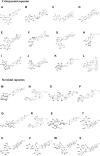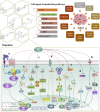Effects of saponins from Chinese herbal medicines on signal transduction pathways in cancer: A review
- PMID: 37063281
- PMCID: PMC10090286
- DOI: 10.3389/fphar.2023.1159985
Effects of saponins from Chinese herbal medicines on signal transduction pathways in cancer: A review
Abstract
Cancer poses a serious threat to human health, and the search for safe and effective drugs for its treatment has aroused interest and become a long-term goal. Traditional Chinese herbal medicine (TCM), an ancient science with unique anti-cancer advantages, has achieved outstanding results in long-term clinical practice. Accumulating evidence shows that saponins are key bioactive components in TCM and have great research and development applications for their significant role in the treatment of cancer. Saponins are a class of glycosides comprising nonpolar triterpenes or sterols attached to hydrophilic oligosaccharide groups that exert antitumor effects by targeting the NF-κB, PI3Ks-Akt-mTOR, MAPK, Wnt-β-catenin, JAK-STAT3, APMK, p53, and EGFR signaling pathways. Presently, few advances have been made in physiological and pathological studies on the effect of saponins on signal transduction pathways involved in cancer treatment. This paper reviews the phytochemistry and extraction methods of saponins of TCM and their effects on signal transduction pathways in cancer. It aims to provide theoretical support for in-depth studies on the anticancer effects of saponins.
Keywords: Chinese herbal medicine; anti-cancer; signal transduction pathway; steroid saponins; triterpenoid saponins.
Copyright © 2023 Zhu, Sun, Bai, Wang, Yang, Wang and Kuang.
Conflict of interest statement
The authors declare that the research was conducted in the absence of any commercial or financial relationships that could be construed as a potential conflict of interest.
Figures




References
Publication types
LinkOut - more resources
Full Text Sources
Research Materials
Miscellaneous

